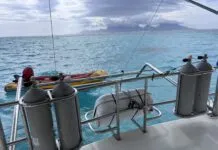This is not your usual Used Boat Survey. Then again, the MacGregor 26 is not your usual boat. We first reviewed Roger MacGregors water-ballasted trailer sailer in 1987, and while we think our conclusions about construction and performance are still valid, weve received many letters from MacGregor owners saying our criticisms-especially our reservations about centerline water ballast-are at worst unfair, at best suffering from a lack of perspective.

In an effort to give owners a forum for their views (and who know these boats better?), in early 1995 we solicited comments. Many owners mailed us long, detailed letters, on which this review heavily relies.
The Original MacGregor 26 Review
To recap the earlier article, heres a brief list of what we liked about the MacGregor 26, and what we didnt:
Pluses
Good dealer support
Efficient jigged production reduces costs
Innovative daggerboard and rudder design
Positive flotation
Above average quality sails
Simple mast-raising system
Through-bolted hull-deck joint
A lot of boat for the money
Minuses
Quick and dirty construction
Many deck fittings without backing plates
Plywood deck core more likely to absorb water than balsa
No structural bulkheads to take rigging loads in heavy conditions
Minimal rig: articulated spreaders; Nico-pressed eyes; plate adjusters instead of turnbuckles
Heavy in the ends, due to long water ballast tank
Trailer not galvanized
No table or icebox
Little stowage space
Cramped leg room in cockpit, and low seatbacks
Some of our criticisms were later addressed. For example, the sloppy tiller-to-rudder assembly was improved, space under the V-berth was opened up, provision was made for an optional boom vang, the trailer was fitted with a jack stand, and a demountable table provided.
History of the MacGregor 26
Roger MacGregors story would make Horatio Alger proud. He founded the MacGregor Yacht Corp. in 1964 to prove the validity of his Stanford MBA thesis that boatbuilders would be more successful if they were more efficient. By 1967 he decided to treat the business as more than an intellectual exercise or hobby. The boats were first called Ventures. The 21, 22, 222, 23, 24 and 25 were all entry-level trailer sailers, marketed to beginning sailors, which has always been MacGregors perceived niche. Two exceptions were a 36′ catamaran and a 65′ ultra-light displacement boat (ULDB).
The MacGregor 26, introduced in 1986, is a development of the 25, but with water ballast instead of a swing keel. MacGregor told us that in the spring of this year he took the 26 out of production, having built about 7,000. It has been replaced with the 26x, he said. We expect to build about 900 of the new boats in the next 12 months. The 26x took off so fast that we are ending production on our 65 and the MacGregor 19 in order to free up space. In total, he built 105 65s and about 2,000 19s. These are impressive numbers, proving (in addition to his near 30-year run in the business) that there are a lot of people interested in sailing if the price is right, and that efficient production methods (in 1987 we called it corner-cutting) is the only way to deliver it.
The 26x appears to be a cross between the 19 Powersailer and MacGregor 26, incorporating the water ballast system of the latter and the broad stern of the former in order to achieve 25-mph speeds with a 50-hp. outboard. There is full standing headroom and twin kick-up rudders. It sells for $13,990, including trailer, sails, seat cushions, pulpits, lifelines, and electrical system.
Water Ballast of the MacGregor 26
MacGregor says the 26 is self-righting, with its 1,200 lbs. of water sealed in the baffled centerline compartment under the sole. After launching, a valve is opened to flood the area, then closed; on haulout, the valve is opened to drain the water. Water, of course, is not particularly dense, nor is its location in this boat very low, so its contribution to righting moment is not as great as one might think.

An owner in Oregon said, It seems tender initially but recovers nicely. The water ballast system has worked flawlessly. The only negative aspect is that the water does not come out until the boat comes out of the water and two-wheel drive isn’t enough on a steep ramp.
Other comments include:
The ballast tank is a bit slow to fill and far too slow to drain. The ballast tank is too close to the waterline to be effective, and so the boat is very tender. To retain a comfortable heel angle, headsail area must be reduced at 6 to 8 knots (we count our installation of a CDI jib furler among our best investments). Reefing of the main is advisable above 12 knots. Even after taking these precautions, the boat can attain some fairly precarious attitudes as following seas crest below it.
Water ballast works perfectly.
A few capfuls of swimming pool chemicals every week seem to keep bad odors and algae away.
The MacGregors primary strength lies in its water ballast system, and hence, relatively low weight, which allows it to be trailered. These same features become liabilities where sailing/motoring are concerned. The boat is very sensitive to moderate winds, exhibiting strong weather helm. At times, the boat heels uncomfortably (no doubt partly due to the high positioning of the ballast); this can be difficult to correct given the boats very basic sail controls.
The water ballast tank has never been a problem. You do sacrifice some storage room, as well as access to locations for a depth or speed transducer. Theres also no deep bilge, so nowhere to put a pump.
I use a Speedwatch knotmeter [no through-hull transducer] and I epoxied the depth sounder transducer to the top of the water ballast tank under the Vberth. The sounder works fine when the tank is filled.
The water ballast and centerboard give comfortable stability, provided the board is down all the way and the tank is full. Ive never been scared by a gust.
We consider the boat plenty stiff for our sailing. The first sails we added were a storm jib and a trysail, which we have used extensively.
The choice of water ballast versus other types seems reducible to the importance of trailering: If you trailer often to protected waters, water ballast definitely has its virtues. On the other hand, if you wish to do some open-water cruising in higher wind strengths, a keel/centerboard or swing keel provides more stability.
The MacGregor 26 Centerboard
Early boats had daggerboards, but this was changed later to a pivoting centerboard.
The boats slender centerboard is surprisingly efficient. However, it is hung from a 3/8″-diameter cross pin and gains its lateral stability by the blade bearing on the side of the trunk. The inherent slop in this assembly results in a continual thumping as the boat rocks at anchor. The resulting noise is very annoying at bedtime, and it can only be eliminated by fully retracting the board. This action generally induces an equally annoying rolling motion.
The centerboard pivots into a slot molded into the [ballast] tank and so does not intrude into the cabin. Single-handers must leave the tiller to adjust it, because its control line is led to the galley counter and not out to the cockpit.
I keep the centerboard angles at about 45 degrees, which seems to work well. The rudder has to go straight down, but I have rigged a piece of shock cord to hold it in position instead of the solid line supplied.
The board, which weighs 25 lbs., provides good performance, at least according to most owners. However, the owner of a 1991 model said both their rudder and board were inefficient and were being replaced with home-made ones to Computer Keel designs. Another owner said the board often jams in the trunk (due to mud, etc.) and that a pry bar is essential equipment.
Construction of the MacGregor 26
The MacGregor 26s hull is solid fiberglass and the deck is cored with plywood. The hull-deck joint is through-bolted, which is good, but it is sealed with foam weather-stripping, which, according to owners, has a tendency to leak.
The fiberglass liner, which limits hull access, is pressed into wet mat laid on the hull, and vertical surfaces of the mold are tabbed with 8″ woven roving, but without fillets to form a nice, supporting radius between the two surfaces. In 1987, we said that the construction of the 26 was in some ways sloppy, but adequate for the use for which the boat was designed.
This boat has the best glass work of any boat I have owned.
There are only a few places where the hull is thick enough to support screw loads. Limited access makes through bolting unpracticed in many locations. The interior is worse. Much of the sole liner is quite thin and the upper wall and headliner cannot be expected to hold anything heavier than a small plastic fixture. Expect stress cracks to quickly appear in both the cockpit and cabin sole. They will appear later in numerous other locations.

The major drawback to this design is the severely restricted access to either the hull or deck for inspection, repair or customization.
The boat comes with no stern pulpit and a single lifeline that extends neither to the front nor rear of the boat. This is inadequate for keeping adults on board, let alone children. As delivered, the boats electrical distribution system consists of one toggle switch. Power is supplied by a group 24 battery that is afforded neither a containment box nor terminal covers. The boat is wired with what appears to be lamp cord and connections are made with wire nuts. The wire is not tinned and most of the original connections turned to dust within 12 months.
Fittings, hardware, rigging are adequate, but in some areas appear too lightweight and flimsy (gooseneck, mainsheet system and its deck attachment, cam cleats for control lines). The inside liner for the forward cockpit wall was so thin that it was punctured by an errant elbow.
My 1987 MacGregor 26 shows gelcoat cracks at virtually every deck fitting. The cleats are plastic! And there are no bow chocks.
In the MacGregor lay-up scheme, after the first white gelcoat layer is sprayed into the mold, it is followed by a black layer to help show air bubbles during the glassing. Sounds good, except that the black is showing through on the deck, particularly in the molded-in non-skid, so it never looks really clean. Even without full bulkheads, the deck doesn’t seem to oilcan (though at the aft end, the vertical transom does when someone uses the swim ladder. Several fittings are misaligned, such as the simple barrel bolt that locks the enclosed head, and the pop top frame is out of alignment just enough that several mounting points are stressed when it is locked down.
All in all, theres a bit of skimping everywhere you look. Theres not an extra inch of a line or cable (for example, you have to lay across the cabin top to reach the idle jib sheet to prepare for a tack. Come on, Roger!). Bowlines everywhere, not an eye splice to be seen. And theres so much raw fiberglass in the unpainted hull interior, youll spend hours picking fibers out of your skin each time you reach in.
I have several blisters in the gelcoat, in the nonskid areas. In general, the fiberglass is thin. The hulldeck joint is not watertight. The hardware is serviceable, but low-end.
Construction appears to be just strong enough for expected conditions. As one couple told us, they know of MacGregor 26s that have made the passage to Catalina Island, but having been caught in some nasty stuff on the same trip on other boats, they wouldnt take their MacGregor. Most owners seem well aware of the boats limitations.
The MacGregor 26 Rig
The boat is lightly rigged. In 1987 we said the rig was too small for light air, and too flimsy for heavy air. Also, to improve performance one must add the essential controls: mainsheet traveler, boom vang, backstay adjuster, turnbuckles, etc.
It takes about 45 minutes to set up with one person, and somewhat less with two.
It only takes five minutes to get the boat into the water, then five minutes to raise the mast. However, this has very little to do with how long one spends putting the boat into the water and taking it out.
Since getting the boat I have installed at least $1,200 in hardware plus electronics. I now have everything led aft, internal halyards, fully set up for racing and fast, easy reefing.
I wonder if the dinghy-class rigging such as the Nico-press fittings and lack of turnbuckles is too light for this boat. Still, the displacement of this boat suggests its not quite fair to compare its rigging needs to heavier, stiffer boats of similar LOA. For most owners, they and the boat will probably bend before anything breaks.
To make the boat suitable, I have had to add a Harken mainsail traveler, lead the halyards back to the cockpit, add a vang, and make numerous minor improvements. It had a sloppy tiller-to-rudder connection with a 3/8 bolt through sloppy holes in the stainless pipe. I drilled the holes to 1/2″ and inserted a couple of bronze shoulder bushings, which tightened it up greatly at low cost.
I had slugs installed in the mainsail and routed the halyard to a rope clutch in the cockpit. Also replaced the manual shroud adjusters with turnbuckles. This allows me to tune the rig more accurately.
As many readers have pointed out, the MacGregor philosophy is to provide the basic boat and let owners upgrade as they choose. We have no trouble with this, so long as buyers are aware of after-sale expenses.
MacGregor 26 Performance Under Sail
In addition to the rig deficiencies noted above, sailing performance is restricted by fixed bulls-eye jib fairleads and wide sheeting angles due to gunwalemounted shrouds, which obviates the use of a genoa close-hauled.
A Michigan owner, who said he has sailed in a million races from dinghies to 40-footers, wrote, My biggest disappointment is speed. I simply have not been able to sail even close to the PHRF handicap. Our typical speed when cruising is 5 knots.
Two-thirds rigs are very touchy. I do wish it was a 7/8 rig.
The MacGregor is not intended for offshore, and I would not recommend it for coastal cruising either. But for inland use, weekend use, occasional weeklong cruises in protected waters, the boat certainly exceeds any applicable quality standards.
The first thing I noted was that in very light airs, I was overtaking boats that were in a class much superior to mine. You got to be kidding!
Many owners applaud the boats light-air quickness. The low displacement/length ratio of 96 and high sail area/displacement ratio of 19 tell the story. But to perform well in even moderate winds, one must add the necessary controls. Nobody likes to go slow, but the majority of owners seem to be family cruisers, for whom an extra half-knot doesn’t mean that much.
Performance Under Power
Owners like the transom-mount for the outboard. Most, but not all, said the engine controls were easy to reach (varies with motor brand).

The typical 8-hp. long-shaft outboard is adequate for most conditions. Only when trying to race back to shore in the teeth of a squall did it fail to make headway. The position of the engine in the motor well makes it comfortable to operate. Turning both the rudder and engine will get the boat to turn just about within its own length.
I have a Yamaha four-stroke 9.9-hp. engine with a large propeller geared down and an extra long 25 shaft with 6-gallon tank in the same well with the motor.
Maneuvering is much crisper with the centerboard down.
With our 8-hp. outboard at half-throttle, fuel consumption is about 14 mpg. No problem maintaining 5 knots.
Low speed steering is non-existent. Were not sure where the Yamaha owner above found space in the well for his 6-gallon tank as a number of others said there was no designated place for it.
MacGregor 26 Interior Details
The 7′ 11″ beam and high freeboard make for a large interior, though there is little stowage space; drawers and lockers are labor intensive and counter to MacGregors philosophy.
A California owner said, Because of its voluminous living space we selected the MacGregor over the pricey Schock and better built Hunter. With its relatively high aft freeboard and shallow cockpit, there is room for an aft berth that we have not found in boats as large as 35′. Our family could bed down without converting any of the other living space. While the enclosed head area is functional, it best serves to hold an enormous amount of gear out of the way and out of sight. Other than being spacious, the boat is nearly unlivable and only marginally ready for sail as delivered. A couple hundred hours of work and $4,000 were required to outfit the boat to our satisfaction.
The queen-size berth [6′ x 7′] under the cockpit is quite comfortable. Its possible to customize. Step one, get rid of that mirror over the galley sink. Its on one of the few usable wooden surfaces for mounting shelves and other things. Forget about cooking inside; youll need the minimal counter space for preparation. We use a gas grill either mounted to the stern rail or on a low stand on the cockpit floor.
The all-fiberglass interior is extremely easy to keep clean. The way the interior liner is installed there is a crack at mid-height that allows one to reach inside between the liner and the hull. I have installed grounding wires, additional electrical wires, etc., in this space.
The huge lazarette can smuggle six Cubans. Underway, the tiller is in the way of access. Fantastic ventilation with the hatch and pop top open. The galley with integral sink is a laugh. It is a catch-all, and quite simply, we have never used ours.
The cabin of the 26 extends to the rail, making for a large interior. Later improvements to the galley alleviate some of the above concerns. Stowage seems to be the chief annoyance, as few find the space under settees convenient or particularly dry.
The MacGregor Trailer
MacGregor makes its own trailers of painted steel. California environmental regulations evidently prohibit galvanizing. Too bad. Rust becomes a challenge from day one. A retaining clip on one of the leaf springs rotted away within two years.
The MacGregor needs only 15 inches of water to float and sits very low on its trailer.
The trailer cross member loved to bite chunks out of the bow gelcoat until I placed a roller 6″ aft of this C-channel.
Future buyers of the 26x might inquire if a credit could be had to forego the trailer; especially if used in saltwater, it would be worth some extra dollars to buy a galvanized trailer.
Summary
Despite the many criticisms, nearly every owner finished his report saying that all things considered, the boat is a good value that gets one out on the water at a bargain price. Better to be sailing than waiting for a promotion that may never come. One owner likened the 26 to the Volkswagen minibus of Alices Restaurant fame. There is a place in the world for the MacGregor 26, and 7,000 owners are glad Roger recognized this. Its price in the spring of this year was $11,990, including trailer, sails, cushions and electrical system. Notable options were surge brakes for the trailer ($279), spinnaker ($495), vang ($69), toilet ($98) and mast raising system ($98).
A fun, quick weekender. With practice and a few tweaks, you can blow the boards off floating parlors of similar length. Most things can be upgraded, but the process will be tricky.
All in all, as you said in 1987, it is a good buy at the price. I consider that I got what I paid for.
I love the idea that my boat can go 60 mph wherever I please! My Mac is simply a great family and friends boat, and I wish Id bought one 15 years ago.
The cost of the MacGregor is a very important factor for someone like me. While you might be able to find a used boat that costs the same, I would be very wary that I might be buying someone elses problems.
Out of the box, the Mac 26 is not a boat at all. It is a boat kit. It is a hull, deck, mast and two sails with a few essential pieces of line thrown in. More stuff will raise the entry price quite a bit. I have made countless modifications. Fit and finish are not really relevant topics. The boat is mass produced. You can customize like a madman; I really think this accounts for much of the rabid devotion of some owners. They did much of the design and it suits their tastes.

































